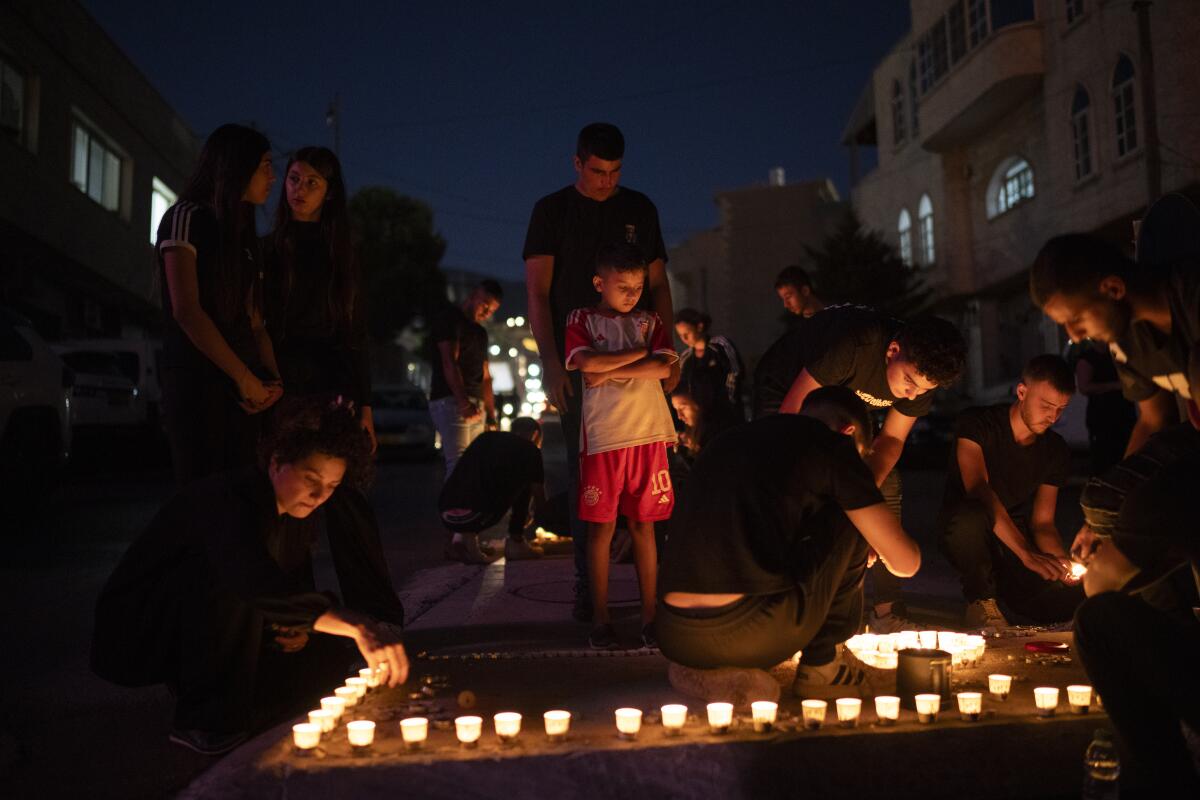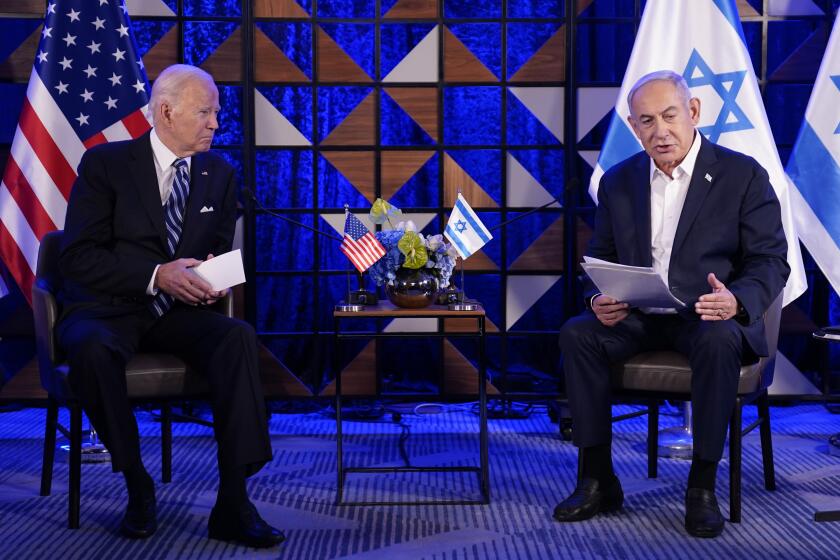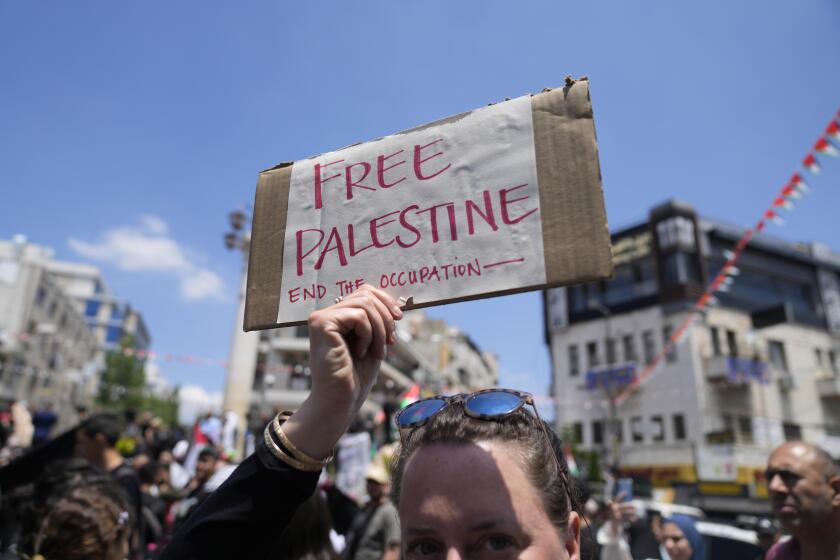Opinion: Hezbollah’s deadly rockets aren’t the most serious threat to Israel’s northern border

- Share via
After nearly 10 months of constant rocket and drone attacks across the Israel-Lebanon border, Israel and Hezbollah stand at the brink of full-scale war for the first time since 2006. But more dire than Hezbollah’s rocket arsenal is the threat that it will launch an Oct. 7-style ground incursion into Israel.
The immediate crisis is a result of what Israel officials say was a Hezbollah rocket attack that killed 12 Israeli Druze youths. Since the day after Hamas’ Oct. 7 massacre, Hezbollah has been firing rockets into Israel almost daily. While the majority of the strikes have used anti-tank guided missiles, the group has also used longer-range, more powerful munitions provided by Iran. That was apparently the case on July 27, when Hezbollah is accused of firing an Iranian Falaq-1 rocket toward the Israeli-controlled Golan Heights and striking a soccer field and playground in the Druze community of Majdal Shams. (Though Israel released data on the rocket and its trajectory that tie it to Hezbollah, the group has issued a rare denial of responsibility for the attack.)
Three days later, an Israeli airstrike killed the Hezbollah military commander Fuad Shukr in Beirut. And the day after that, an explosion widely attributed to Israel killed the Hamas leader Ismail Haniyeh at a guesthouse in Tehran. The region is now on pins and needles awaiting reprisals from Iran, Hezbollah and perhaps other Iranian proxy groups, risking escalation and wider war.
The bloodiness of the Netanyahu government’s response to Hamas’ shocking Oct. 7 attack has accelerated a political shift that has been underway for more than a decade.
And yet there is hope for de-escalation. The factors that have prevented Hezbollah from opening a full-fledged second front for Israel since October still hold true. Lebanon continues to suffer a devastating economic (and political) crisis, and most of its citizens don’t want Hezbollah to drag the country into what would probably be a terribly destructive war. And while Iran is happy to fight to the last Arab proxy, its leaders don’t want war to spill over their own borders.
But it’s too early to count on cooler heads. The Hezbollah leader Hassan Nasrallah has pledged to continue firing rockets into Israel until the fighting stops in Gaza. And even if a cease-fire deal is reached and the rockets stop, more than 60,000 Israeli civilians displaced from their homes along the border with Lebanon will not return until the threat posed by Hezbollah ground forces is dealt with. My recent visit to Israel’s evacuated northern border drove home the extent to which residents of the area fear an Oct. 7-style raid, distrust their leaders’ security guarantees and will resist returning to their homes without a more convincing answer to the threat.
Pushing and pleading with Israel to participate in a two-state process is a waste of time. The international community can initiate a different way forward.
They have good reason for concern. The Hamas massacre came straight out of Hezbollah’s playbook. The Israeli military has been actively training for years to counter a Hezbollah plot to overrun Israeli communities, kill and kidnap civilians, and undermine Israel’s sense of security. Part of what was unexpected about Oct. 7 was that it happened on the southern rather than the northern border.
Moreover, after its 2006 war with Israel, Hezbollah built an arsenal of some 150,000 rockets, deployed forces throughout southern Lebanon and otherwise violated a U.N. Security Council resolution meant to prevent further conflict.
Israelis displaced from the north are beginning to learn just how close to disaster they also came on Oct. 7. As Hamas terrorists streamed across the southern border that day, only two Israeli battalions comprising about 600 personnel were covering the entire northern border. Today some 40 battalions defend that border, but such a deployment is difficult to maintain over the long haul.
Israeli officials are under tremendous pressure to return their citizens to the sovereign territory Hezbollah has effectively depopulated for most of a year. They have indicated that if Hezbollah doesn’t agree to retreat from the border, Israel will clear it by force.
U.S. diplomatic efforts have focused on getting Hezbollah to pull all its forces at least 10 kilometers from the border. This would put most of its missiles out of range and make an Oct. 7-style surprise attack much less likely.
Some within the Israel Defense Forces advocate neutralizing the Hezbollah threat now, while the group has a relatively small share of its extensive forces sitting on the border, Israeli troops are fully deployed in the north and civilians are already displaced from the area. But most Israeli officials understand that a war with Hezbollah today would be like no war Israel has ever fought. They would prefer to let the current war end, send exhausted reservists home, allow displaced families to leave the hotel rooms they have lived in for many months and take a couple of years to restock munitions and plan for a war with Hezbollah. But if Israeli civilians are unable to return to their homes soon, the war may come much sooner than they would like.
Across the country and its political spectrum, Israelis agree that they can no longer live with a gun to their heads, not from the south or from the north. The idea that enemies sworn to destroy them can be allowed to amass massive arsenals on their borders is no longer tenable. That means that Israel will ultimately have to address both Hezbollah’s rocket stockpile and its 30,000-strong standing militia. And it’s the latter that’s more likely to drag Israel into a war that most Israelis and Lebanese don’t want.
Matthew Levitt is the Fromer-Wexler senior fellow and director of the Reinhard program on counterterrorism and intelligence at the Washington Institute for Near East Policy and the author of “Hezbollah: The Global Footprint of Lebanon’s Party of God,” the latest edition of which is to be released in September.
More to Read
A cure for the common opinion
Get thought-provoking perspectives with our weekly newsletter.
You may occasionally receive promotional content from the Los Angeles Times.












